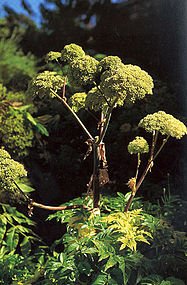Angelica archangelica

Angelica archangelica, commonly known as garden angelica, wild celery, and Norwegian angelica, is a biennial plant from the family Apiaceae, a subspecies of which is cultivated for its sweetly scented edible stems and roots. Like several other species in Apiaceae, its appearance is similar to several poisonous species (Conium, Heracleum, and others), and should not be consumed unless it has been identified with absolute certainty. Synonyms include Archangelica officinalis Hoffm. and Angelica officinalis Moench.[3]
During its first year, it grows only leaves, but during its second year, its fluted stem can reach a height of 2.5 meters (just over 8 feet), and the root is used in flavoring preparations. Its leaves consist of numerous small leaflets divided into three principal groups, each of which is again subdivided into three lesser groups. The edges of the leaflets are finely toothed or serrated. The flowers, which blossom in July, are small and numerous, yellowish or greenish, are grouped into large, globular umbels that bear pale yellow, oblong fruits. Angelica grows only in damp soil, preferably near rivers or deposits of water.
Angelica archangelica grows wild in Russia, Finland, Sweden, Norway, Denmark, Greenland, the Faroe Islands, and Iceland, mostly in the northern parts of the countries. It is cultivated in France, mainly in the Marais Poitevin, a marsh region close to Niort in the department Deux-Sèvres. Commercially available sources of angelica are often sourced from Hungary, Romania, Bulgaria, Germany and Poland.[citation needed]
